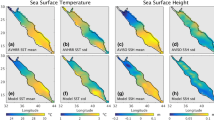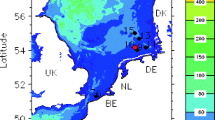Abstract
We present the implementation and results of a model tuning and ensemble forecasting experiment using an ensemble Kalman filter for the simultaneous estimation of 12 parameters in a low resolution coupled atmosphere-ocean Earth System Model by tuning it to realistic data sets consisting of Levitus ocean temperature/salinity climatology, and NCEP/NCAR atmospheric temperature/humidity reanalysis data. The resulting ensemble of tuned model states is validated by comparing various diagnostics, such as mass and heat transports, to observational estimates and other model results. We show that this ensemble has a very reasonable climatology, with the 3-D ocean in particular having comparable realism to much more expensive coupled numerical models, at least in respect of these averaged indicators. A simple global warming experiment is performed to investigate the response and predictability of the climate to a change in radiative forcing, due to 100 years of 1% per annum atmospheric CO2 increase. The equilibrium surface air temperature rise for this CO2 increase is 4.2±0.1°C, which is approached on a time scale of 1,000 years. The simple atmosphere in this version of the model is missing several factors which, if included, would substantially increase the uncertainty of this estimate. However, even within this ensemble, there is substantial regional variability due to the possibility of collapse of the North Atlantic thermohaline circulation (THC), which switches off in more than one third of the ensemble members. For these cases, the regional temperature is not only 3–5°C colder than in the warmed worlds where the THC remains switched on, but is also 1–2°C colder than the current climate. Our results, which illustrate how objective probabilistic projections of future climate change can be efficiently generated, indicate a substantial uncertainty in the long-term future of the THC, and therefore the regional climate of western Europe. However, this uncertainty is only apparent in long-term integrations, with the initial transient response being similar across the entire ensemble. Application of this ensemble Kalman filtering technique to more complete climate models would improve the objectivity of probabilistic forecasts and hence should lead to significantly increased understanding of the uncertainty of our future climate.











Similar content being viewed by others
References
Andronova NG, Schlesinger ME (2001) Objective estimation of the probability density function for climate sensitivity. J Geophysical Res 108(D8):22605–22611
Annan JD, Hargreaves JC (2004) Efficient parameter estimation for a highly chaotic system. Tellus (in press)
Annan JD, Hargreaves JC, Edwards NR, Marsh R (2004) Parameter estimation in an intermediate complexity Earth System Model using an ensemble Kalman filter. Ocean Model (in press)
Bennett AF (1978) Poleward heat fluxes in Southern Hemisphere Oceans. J Phys Oceanography 8:785–798
Böning CW, Bryan FO, Holland WR, Döscher R (1996) Deep water formation and meridional overturning in a high-resolution model of the North Atlantic. J Phys Oceanography 26:1142–1164
Broecker WS (1997) Thermohaline circulation, the Achilles heel of our climate system: will man-made CO2 upset the current balance? Science 278:1582–1588
Bryden HL, Roemich DH, Church JA (1991) Ocean heat transport across 24°N in the Pacific. Deep Sea Res 48:297–324
Collins M, Allen MR (2002) Assessing the relative roles of initial and boundary conditions in interannual to decadal climate predictability. J Climate 15(21):3104–3109
Cubasch U, Meehl A, Boer GJ, Stouffer RJ, Dix M, Noda A, Senior CA, Raper S, Rap KS (2001) Projections of future climate change. In: Houghton JT, Ding Y, Griggs DJ, Nouger M, Linden PJVD, Dai X, Maskell K, Johnson CA (eds) Climate change 2001: the scientific basis. Contribution of working group 1 to the third assessment report of the intergovernmental panel on climate change, Cambridge University Press, Cambridge, pp 525–582
Edwards NR, Marsh R (2003) Uncertainties due to transport-parameter sensitivity in an efficient 3-D ocean-climate model. Climate Dyn (submitted)
Edwards NR, Shepherd JG (2002) Bifurcations of the thermohaline circulation in a simplified three-dimensional model of the world ocean and the effects of interbasin connectivity. Climate Dyn 19:31–42
Evensen G (1994) Sequential data assimilation with a nonlinear quasi-geostrophic model using Monte Carlo methods to forecast error statistics. J Geophysical Res 99(C5):10143–10162
Forest CE, Allen MR, Stone PH, Sokolov AP (2000) Constraining uncertainties in climate models using climate change detection techniques. Geophysical Res Lett 27:569–572
Fukumori I (2001) Data assimilation by models, chapter 5. Academic, pp 237–265
Ganachaud A, Wunsch C (2000) Improved estimates of global ocean circulation, heat transport and mixing from hydrographic data. Nature 408:453–457
Gregory JM, Stouffer RJ, Raper SCB, Stott PA, Rayner NA (2002) An observationally based estimate of the climate sensitivity. J Climate 15(22):3117–3121
Hansen J, Sato M, Nazarenko L, Ruedy R, Lacis A, Koch D, Tegen I, Hall T, Shindell D, Stone P, Novakov T, Thomason L, Wang R, Wang Y, Jacob D, Hollandsworth-Frith S, Bishop L, Logan J, Thompson A, Stolarski R, Lean J, Willson R, Levitus S, Antonov J, Rayner N, Parker D, Christy J (2002) Climate forcings in Goddard Institute for Space Studies SI2000 simulations. J Geophys Res 107(D18):4347–4384
Hargreaves JC, Annan JD (2002) Assimilation of paleo-data in a simple Earth system model. Climate Dyn 19(5–6):371–381
Hibler WD (1979) A dynamic thermodynamic sea ice model. J Phys Oceanography 9:815–846
Holfort J, Siedler G (2001) The meridional oceanic transports of heat and nutrients in the South Atlantic. J Phys Oceanography 31:5–29
Houghton JT, Ding Y, Griggs DJ, Noguer N, Linden PJVD, Dai X, Maskell K, Johnson CA (2001) Climate change 2001: contribution of working group I to the third assessment report of the intergovernmental panel on climate change. Cambridge University Press
Jia Y (2003) Ocean heat transport and its relationship to ocean circulation in CMIP. Climate Dyn 20:153–174
Josey SA, Kent EC, Taylor PK (1998) The Southampton Oceanography Centre (SOC) ocean—atmosphere heat, momentum and freshwater flux atlas, Technical Report 6, Southampton Oceanography Centre
Keppenne CL (2000) Data assimilation into a primitive-equation model with a parallel ensemble Kalman filter. Monthly Weather Rev 128:1971–1981
Knutti R, Stocker TF, Joos F, Plattner G-K (2002) Constraints on radiative forcing and future climate change from observations and climate model ensembles. Nature 416:719–723
Lambert SJ, Boer GJ (2001) CMIP1 evaluation and intercomparison of coupled climate models. Climate Dyn 17:83–106
Latif M, Roeckner E, Mikolajewicz U, Voss R (2000) Tropical stabilisation of the thermohaline circulation in a greenhouse warming simulation. J Climate 13:1809–1813
Levitus S (1998) World Ocean Atlas. http://www.cdc.noaa.gov/
Levitus S, Antonov JI, Boyer TP, Stephens C (2000) Warming of the world ocean. Science 287:2225–2229
Oort AH (1983) Global atmospheric circulation statistics, 1958–1973, NOAA Professional Paper 14
Press WH, Teukolsky SA, Vetterling WT, Flannery BP (1994) Numerical recipes in Fortran: the art of scientific computing. Cambridge University Press, Cambridge
Rahmstorf S, Ganopolski A (1999) Long-term global warming scenarios computed with an efficient coupled climate model. Climatic Change 43:353–367
Saunders PM, Coward AC, de Cuevas BA (1999) Circulation of the Pacific Ocean seen in a global ocean model (OCCAM). J Geophys Res C8:18281–18299
Semtner AJ (1976) A model for the thermodynamic growth of sea ice in numerical investigations of climate. J Phys Oceanography 6:379–389
Stouffer RJ, Manabe S (2003) Equilibrium response of thermohaline circulation to large changes in atmospheric CO2 concentration. Climate Dyn 20:759–773
Thacker WC (2003) Data-model-error compatibility. Ocean Model 5:233–247
Trenberth KE, Caron JM (2001) Estimates of meridional atmosphere and ocean heat transports. J Climate 14:3433–3443
Trenberth KE, Caron JM, Stepaniak DP (2001) The atmospheric energy budget and implications for surface fluxes and ocean heat transports. Climate Dyn 17:259–276
Weaver AJ, Eby M, Wiebe EC, Bitz CM, Duffy PB, Ewen TL, Fanning AF, Holland MM, MacFadyen A, Matthews HD, Meissner KJ, Saenko O, Schmittner A, Wang HX, Yoshimori M (2001) The UVic Earth System Climate Model: Model description, climatology, and applications to past, present and future climates. Atmosphere Ocean 39(4):361–428
Weijer W, de Ruijter WPM, Dijkstra HA, van Leeuwen PJ (1999) Impact of interbasin exchange on the Atlantic overturning circulation. J Phys Oceanography 29:2266–2284
Whitworth T, Peterson RG (1985) Volume transport of the Antarctic Circumpolar Current from bottom pressure measurements. J Phys Oceanography 15:810–816
Wiebe EC, Weaver AJ (1999) On the sensitivity of global warming experiments to the parameterization of sub-grid scale mixing. Climate Dyn 15:875–893
Acknowledgements
NRE is currently supported by the Swiss NCCR-Climate programme. RM is supported by the Natural Environment Research Council (NERC) Core Strategic Programme “Ocean Variability and Climate”. Supercomputer facilities and support were provided by JAMSTEC. This research was partly supported by the GENIE project (http://www.genie.ac.uk/), which is funded by the NERC (NER/T/S/2002/00217) through the e-Science programme.
Author information
Authors and Affiliations
Corresponding author
Rights and permissions
About this article
Cite this article
Hargreaves, J.C., Annan, J.D., Edwards, N.R. et al. An efficient climate forecasting method using an intermediate complexity Earth System Model and the ensemble Kalman filter. Climate Dynamics 23, 745–760 (2004). https://doi.org/10.1007/s00382-004-0471-4
Received:
Accepted:
Published:
Issue Date:
DOI: https://doi.org/10.1007/s00382-004-0471-4




